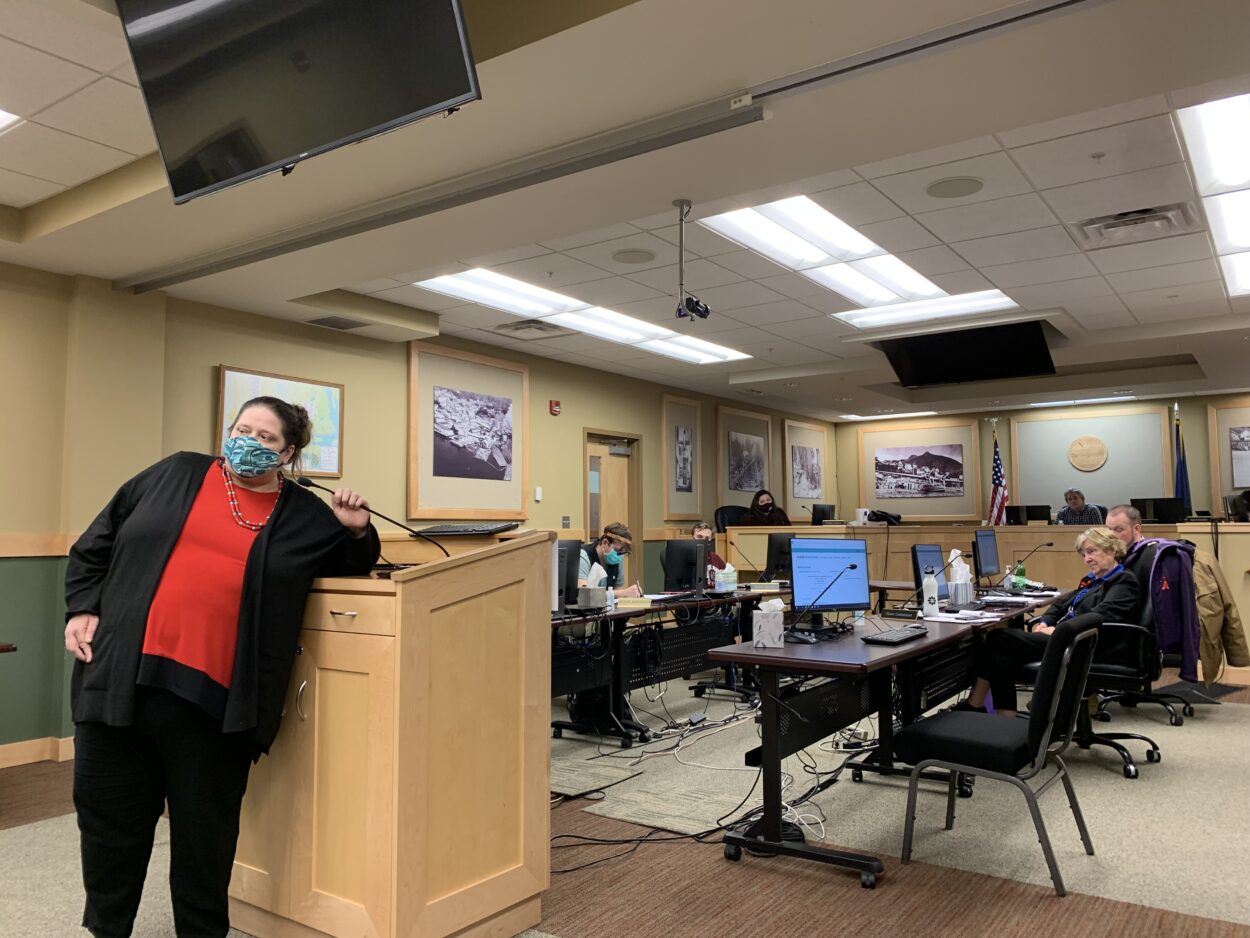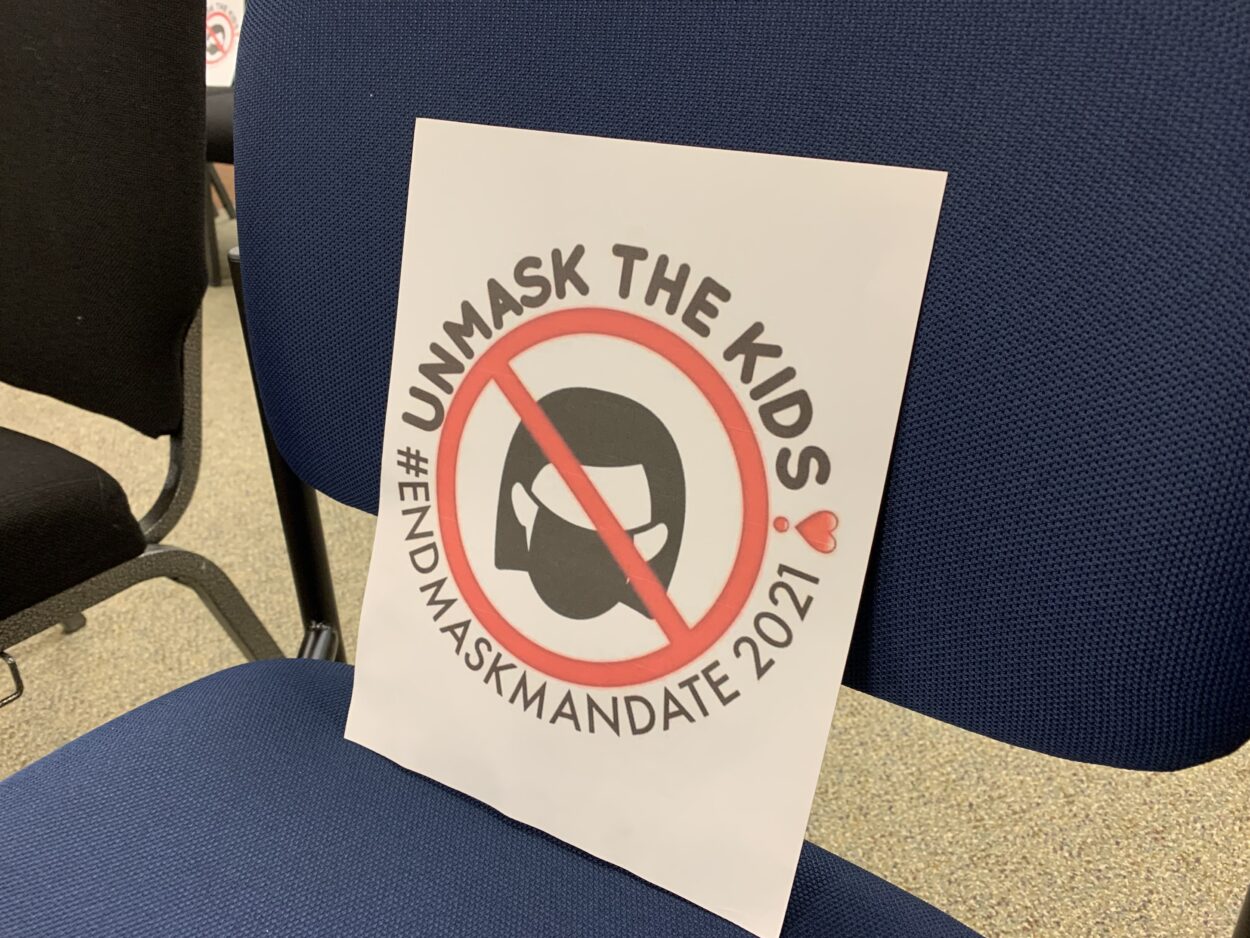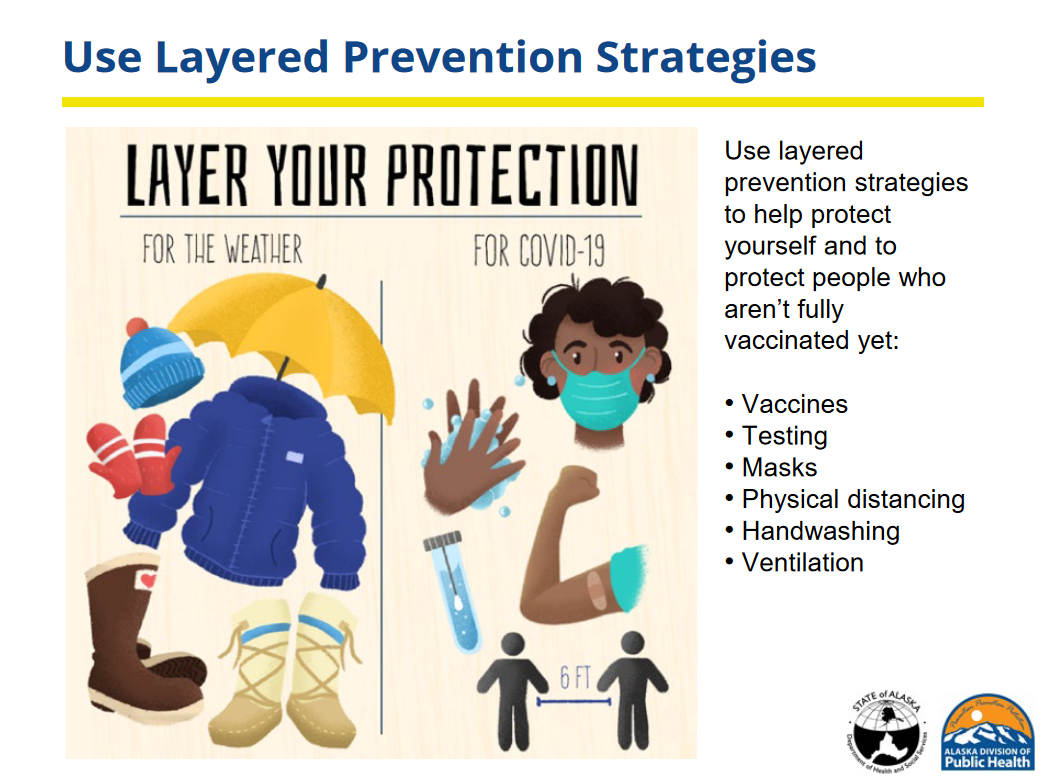
Ketchikan Indian Community Tribal Council President Gloria Burns speaks during public comment at Wednesday’s school board meeting as the board looks on. (Eric Stone/KRBD)
A 5-2 vote by Ketchikan’s school board has effectively loosened the school district’s mask rules going forward.
The school board’s action on Wednesday evening followed nearly two hours of testimony from state public health officials and medical professionals who argued that masks, vaccines and other precautions are needed to keep COVID-19 numbers down in the community.
Audio Player
The COVID situation in Ketchikan is, to put it mildly, not good. The number of people infected is near record levels. Ketchikan’s hospital has seen record-high numbers of COVID-19 patients in recent days, even as cases statewide have fallen.
“First of all, I would just say, you’ve got a lot of COVID circulating in Ketchikan right now, so you have to take that into consideration,” Dr. Anne Zink, Alaska’s chief medical officer, told Ketchikan’s school board during a one-hour presentation from state health officials.
And the surge is straining some medical resources in Ketchikan, according to South Tongass Fire Chief Steve Rydeen. He says first responders are struggling to keep up with the volume of COVID-19-related calls.
“We’re averaging two calls a day on just the south end, backing up the city because they’re maxed out,” Rydeen said at the meeting. “COVID, unfortunately, is something that we need to get ahead a handle on again, just like we did in the very beginning.”
The purpose of the meeting was to hear input from experts before considering whether to loosen Ketchikan’s rules that require everyone to wear masks on public school campuses. In recent weeks a vocal group of parents has called for more flexibility or an end to masks altogether. Some carried signs with slogans like “unmask the kids.”

An anti-mask mandate sign sits on a chair after Wednesday’s meeting of Ketchikan’s school board. (Eric Stone/KRBD)
“We are traumatizing these kids,” Christy Willis told the board.
“The science depends on what channel you’re watching on TV,” Kirk Thomas said.
“Last time I checked, we still lived in the United States of America, not in the days of Nazi Germany,” Heather Dalin said.
Their position was by no means universal, though. The head of Ketchikan Indian Community’s Tribal Council spoke out, saying eight people of American Indian descent had died of COVID-19 in Ketchikan alone.
“I knew all of them. The people in my community knew all of them,” Burns said. Across the state, Alaska Native and American Indian people make up an disproportionate share of COVID-19 hospitalizations and fatalities, according to state health department data.
But first came the health professionals. Dr. Zink said that rules requiring masks and other measures have proven more effective than earlier advice such as deep-cleaning.
“We did lots of cleaning and things like that, or closing rooms down for 72 hours,” Zink said. “The data really isn’t showing that that makes a difference.”
She pointed to a Centers for Disease Control and Prevention study from Arizona that showed that schools without mask mandates are 3.5 times more likely to see COVID-19 outbreaks. And Zink says studies have proven time and again that masks are safe to wear.
“Things like distancing, ventilation, masking and vaccination that we talked about, those are our most effective tools, and you want to be careful when you’ve got a lot of COVID,” Zink said.
The state health officials said that while COVID-19 is generally less severe in kids, 923 children had died in the U.S. since the pandemic began. That’s more than twice the pediatric death rate for the deadliest flu season in recent years in which 199 children died. And Zink said roughly half of people infected with COVID-19 have lingering symptoms months afterward.
“About half the people who experience COVID will develop long COVID-like symptoms and see their primary care provider or some specialists within six months of their initial diagnosis. And sometimes these can be really debilitating — like a kid I saw who everything tastes and smells like sewer still, months after their initial diagnosis,” she said.

State health officials showed a slide deck that included information about “layered” prevention strategies for COVID-19, including vaccination, testing and masks. The full slide deck is available here. (Alaska Department of Health and Social Services)
Ketchikan’s public health professionals also showed up. State public health nurse Jennifer Bergen said Ketchikan’s mask mandate in schools was helping to keep a lid on spread, “but we are still seeing cases. So imagine taking away those layers, what the result is going to be from that,” Bergen said. “You are going to see increased transmission in schools.”
The president of Ketchikan’s teacher’s union, Gara Williams, said that masks were the last significant anti-COVID measure remaining at Ketchikan High School, known locally as Kayhi, where she teaches.
“We don’t have cohorts at Kayhi. We don’t have small groups. We don’t have the 50-50 model like we did last year,” she said. “Our mitigation is wearing masks.”
Then the board got down to business. Board Member Paul Robbins Jr. got the ball rolling.
“Just to put the biggest argument forward first, I’m going to make a motion to change masking to optional under the substantial (COVID-19 risk level), which I believe is the third under high risk,” Robbins said.
That would make masks optional at all but the highest school district COVID-19 risk level. Essentially, when there are fewer than 50 cases in Ketchikan, students would not be required to mask up at school, though athletes and spectators would still be required to wear a mask in line with regional interscholastic rules, and a federal mandate requires masks on school buses.
School Board President Stephen Bradford said he was concerned the district might not have enough substitute teachers to handle a potential uptick in absences. But Bradford said the fact that students five and older are now eligible for the COVID-19 vaccine changed his calculation. He supported the move.
“I still believe that we need to move towards an end to the masking requirements,” Bradford said.
Board Members Nicole Anderson and Diane Gubatayao also voiced support.
Board Member Bridget Mattson supported the move, but she added a significant caveat. She said the change would allow school administration to require masks at schools with outbreaks.
Mattson also advised school principals to draw up plans for potential shutdowns.
“I believe that if we’re looking at rolling back the mitigation efforts that are left in the plan that are keeping the school going — as as they are, they’re already stretching our capacity — we have to understand that we will need to make a plan for having children out of schools,” she said, “which is heartbreaking to me.”
The prospect of school closures led the board’s student member, Ketchikan High School Student Body President Braxton Zink, to speak out in favor of keeping the mask rule as-is. The board’s student member casts nonbinding advisory votes as the voice of the student body.
“I’m not going to try to amend or try to push forward having more COVID mitigation. That’s for you to decide,” he said. “But I am going to voice out that I don’t think that we should, for lack of a better term, give up.”
The sentiment was shared by elected board member Keenan Sanderson.
“We don’t know what’s going to happen if we take masks away out of the schools,” he said.
Sanderson joined Board Member Jordan Tabb in opposing the measure. It passed 5-2.
As of Dec. 6, high school and middle school students will be allowed to remove their masks if fewer than 50 cases of COVID-19 are active in Ketchikan. The change takes effect at elementary schools after winter break.
Had these rules been in effect all along — assuming the same case numbers — masks would have been mandatory for all but two weeks during the school year to date.
Separately, the board voted down a proposal that would have lifted mask requirements for gym classes altogether. That failed 2-5 with only board members Anderson and Gubtayao in support.
Interim Superintendent Melissa Johnson also announced the school district would stand up a program that allows students who might ordinarily have to quarantine following COVID-19 exposure to remain in school by testing negative. The opt-in program is set to begin after Thanksgiving.
Disclosure: School Board President Stephen Bradford is married to a member of KRBD’s nonprofit board of directors. The board is not involved in directing news coverage.





